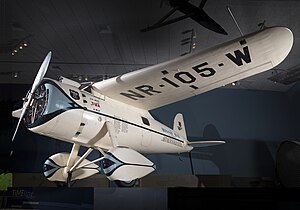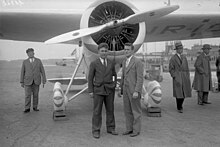| Winnie Mae | |
|---|---|
 Winnie Mae at the Smithsonian's Steven F. Udvar-Hazy Center Winnie Mae at the Smithsonian's Steven F. Udvar-Hazy Center | |
| General information | |
| Type | Lockheed Vega |
| Manufacturer | Lockheed Corporation |
| Owners | Florence C. Hall, Wiley Post |
| Registration | NR105W |
| History | |
| Manufactured | 1930 |
| Preserved at | Smithsonian Institution displayed at the National Air and Space Museum |
The Winnie Mae is a modified Lockheed 5C Vega flown by Wiley Post during the 1930 National Air Races, winning first place with a time of 9 hours, 9 minutes, and 4 seconds, as well as setting records for the fastest around-the-world flight in 1931, with a time of 8 days, 15 hours, and 51 minutes, the first solo around-the-world flight in 1933, and the flight altitude record in 1934, reaching 50,000 feet. The Winnie Mae was sold to the Smithsonian Institution after Wiley Post's death, where it is currently being displayed at the National Air and Space Museum in Washington D.C.
History
The Winnie Mae was built in 1930 by the Lockheed Corporation in Burbank, California, with the serial number 122 as a Lockheed 5B model. In June of 1930, Florence C. Hall, an oil baron based in Chickasha, Oklahoma, purchased the Winnie Mae for $22,000 and named it after his daughter. The plane had been intended for personal use and Hall's personal pilot, Wiley Post, would pilot the aircraft. On August 27th, 1930, with permission from the plane's owner Florence C. Hall, Wiley Post entered the Winnie Mae in the National Air Races. Winning first place in the men's non-stop cross-country derby securing a cash prize of $7,500 and setting a record time of 9 hours, 9 minutes, and 4 seconds; an achievement which was painted on the plane's fuselage.

On June 23rd, 1931, Wiley Post along with Australian aviator Harold Gatty acting as navigator departed New York in an attempt to beat the record for the fastest around-the-world flight. After 14 refueling stops they landed back in New York on July 1st, 1931, having completed the circuit in 8 days, 15 hours, and 51 minutes. Being the first to complete an around-the-world flight in a fixed-wing aircraft and beating Hugo Eckener's previous record of 21 days, 5 hours, and 31 minutes in a Zeppelin. After completing the flight, Wiley Post acquired Winnie Mae from Florence C. Hall. On July 8th, 1931, Wiley Post competed in the National Air Races again with the Winnie Mae, being beaten by Jimmy Dolittle in a Laird Super Solution.
In 1932, Wiley Post converted the Winne Mae from a Lockheed 5B to a Lockheed 5C model and installed various other modifications. Its Wasp C engine was upgraded with cylinders from a Wasp C1, increasing the horsepower from 420 to 500. Its fixed-pitch propeller was upgraded to a Smith 450-SI variable-pitch propeller, and the wing's angle of incidence was decreased by 10 degrees to increase the plane's airspeed by approximately 10 MPH (16 KPH). In 1933, Wiley Post installed a Sperry gyroscopic autopilot, a fairly new invention at the time, and added six auxiliary fuel tanks in preparation for his solo around-the-world flight, giving the Winnie Mae a fuel capacity of 645 gallons.

On July 15th, 1933, Wiley Post departed Floyd Bennett Airfield, New York, in the Winnie Mae on what would become the first solo around-the-world flight. At 11:58 A.M. (AKST) on July 20th, 1933, after a 3,000-mile leg from Khabarovsk, Siberia to Nome, Alaska, Post overflew his destination and got lost, crash-landing next to a U.S. Army Signal Corps radio station at Flat, Alaska after 7 hours of searching for an airfield. The aircraft's wheels sank into the soft ground causing the plane to nose over, damaging its propeller, engine cowling, and right landing gear strut. Replacement parts were flown in from Fairbanks, Alaska, and after repairs, the Winnie Mae departed Alaska the following day at 7:28 A.M. (AKST). Post completed his record-breaking solo around-the-world flight in 7 days, 18 hours, and 49 minutes, stopping 11 times for fuel. When the Winnie Mae landed back in New York on July 22nd, over 50,000 spectators gathered to catch a glimpse of Wiley Post and his now-famous aircraft.

In early 1934, Wiley Post started modifying the Winnie May for high-altitude long-distance flights, supercharging the engine and adding jettisonable landing gear as well as a skid to land on, this design was chosen to reduce drag on the aircraft. The Winnie Mae could not be pressurized due to its wooden construction, so Post had a full-body pressure suit made with financial support from the Phillips Petroleum Company. On December 7th, 1934, Post flew the Winnie Mae to an estimated fifty thousand feet above Bartlesville, Oklahoma, unofficially setting the flight altitude record for a fixed-wing aircraft. Wiley Post understood that planes fly faster at higher altitudes, so he set out to beat the current cross-country speed record. After four failed attempts, Post settled for the Burbank, California, to Cleveland, Ohio, route, which he completed on March 15, 1935, covering the 2,035 miles in the stratosphere in 7 hours, 19 minutes at an impressive 340 MPH (547 KPH). For comparison, the Lockheed 5C Vega normally had a top speed of 185 MPH (298 KPH). The Winnie Mae was able to achieve its high speeds by flying in the jet stream, a fast-flowing atmospheric air current.
Wiley Post died in a plane crash on August 15, 1935, while flying a modified Lockheed Orion near Point Barrow, Alaska. Shortly after in 1936, Post's wife sold the Winnie Mae for $25,000 to the Smithsonian Institution, which still preserves it at the National Air and Space Museum in Washington, D.C.
Specifications
Data from Lockheed Vega Winnie Mae | National Air and Space Museum
General characteristics
- Crew: 1
- Length: 27 ft 6 in (8.38 m)
- Wingspan: 41 ft (12 m)
- Height: 8 ft 2 in (2.49 m)
- Wing area: 275 sq ft (25.5 m)
- Empty weight: 2,595 lb (1,177 kg)
- Gross weight: 4,500 lb (2,041 kg)
- Fuel capacity: 645 US gal (537 imp gal; 2,440 L)
- Propellers: 2-bladed Smith 450-SI variable-pitch propeller
Performance
- Maximum speed: 340 mph (550 km/h, 300 kn) at 55,000 ft. 185 mph (298 km/h, 161 kn) normally.
- Service ceiling: 50,000 ft (15,000 m) approximately
References
- ^ "Lockheed Vega Winnie Mae | National Air and Space Museum". airandspace.si.edu. Retrieved 2023-12-21.
- ^ Wiley Post: Setting Long-Distance Records in the Winnie Mae, 22 March 2017, retrieved 2023-12-21
- ^ "The Winnie Mae of Oklahoma | This Day in Aviation". 2023-07-22. Retrieved 2023-12-21.
- ^ "Winnie Mae | The Encyclopedia of Oklahoma History and Culture". Oklahoma Historical Society | OHS. Retrieved 2023-12-21.
- ^ "The Winnie Mae | Time and Navigation". timeandnavigation.si.edu. Retrieved 2023-12-21.
- "Stamps Aviation Pioneer Series Adds Pair-for Wiley Post". New York Times. 18 November 1979.
- Maksel, Rebecca. "Wiley Post's Historic Around-the-World Flight". Smithsonian Magazine. Retrieved 2023-12-22.
- Allen, Sally. "Widow of Aviator Wiley Post Dies in Texas After Long Illness". The Oklahoman. Retrieved 2023-12-22.